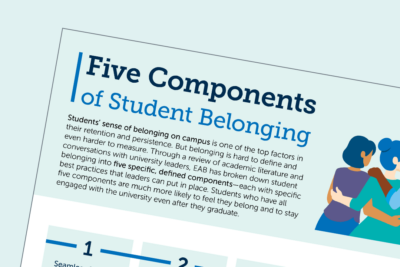Establishing a Sustainable Scope of Service
The growing demand for campus mental health services and the increasing complexity of students’ mental health concerns has prompted difficult questions about the scope of campus care. Institutions recognize they can’t provide all types of services with finite resources.
To keep pace with students’ concerns and address expectations about the availability of care, campus counseling centers need to set and communicate a sustainable scope of service through a scope of care statement.
EAB recommends a clearly defined sustainable scope of service statement based on your institution’s mission, campus resources, and available community support. Use this guide to facilitate a discussion about the priorities of mental health services and the practical limitations of on-campus care. Then, use the templates and best-in-class example statements to compose and share a written scope of service statement.
Scope of services discussion guide
Many institutions are grappling with questions about what the goal of campus mental health services should be. For example, is the goal to help students learn to manage their conditions long-term when they leave campus? Or is the goal to equip students with the immediate information and skills they need now to stay in school and maintain academic performance? Differing perspectives among campus leadership, administrators, and staff can make it challenging to agree on what types of services should and should not be offered on campus.
The first step to setting a sustainable scope of service is to define your institution’s mission and goals when providing mental health services to students. Use this discussion guide with campus leaders and counseling center staff to come to consensus about your institution’s priorities.
Compendium of factors to consider
Once you’ve reached consensus on the mission and goals of your institution’s mental health services, the next step is to review the factors that influence your scope of care. Use this compendium to consider the practical limitations and opportunities of on-campus care. The factors fall into three categories.
Center
- Most common presenting concerns
- Recurring instances of specialized concerns
- Available budget and staffing resources
- Physical space
Campus
- Institutional mission
- Available campus supports and services
- Student and family expectations
Community
- Geographic location and availability of community resources
- Insurance and financial implications
Essential elements for writing a scope of services statement
Now that you’ve reviewed the factors that influence your scope of care, it is time to bring it all together by writing your institution’s scope of care statement. Your statement should be concise, clearly organized, and specific. EAB analyzed existing statements and identified eight essential elements to structure a scope of care. You can also access sample statements from other institutions in the Appendix for inspiration.
Communicating your scope of services
Sharing your scope of care statement early and often helps set expectations about on-campus care options and referral processes. EAB recommends communicating your scope of care statement through a variety of channels and reinforcing the center’s services over time.
4 ways to share your scope of care statement
Post it online
First and foremost, it’s essential to openly share your institution’s scope of care statement. Post the statement on your counseling center webpage to ensure that it is immediately visible to website visitors seeking information about campus services. Include hyperlinks to other relevant campus services, community providers, or related resources.
Send a pre-orientation letter
Today, more students come to campus with a history of mental health conditions or treatment. Send a letter to new students and their families before they come to orientation about the scope of campus services. Set expectations about available care options and educate them about referral protocols so they can ensure continuity of care as students transition to campus.
Host an orientation session
Orientation presents a ripe opportunity to connect with students and their families about campus services and options. At orientation, include information about your scope of service, including what services are offered on campus and what conditions or circumstances might require off-campus care. Encourage parents and families to discuss care options with their students before coming to campus.
Integrate it in an email campaign
Many campuses send emails reminding students and families about campus mental health services during particularly stressful times of year, such as midterms and finals. Integrate information about your institution’s scope of care into these emails to ensure that students understand the types of services they can access across the year.
Appendix: Sample scope of care statements
This appendix features scope of care statements from eight U.S. colleges and universities. Statements are organized by institution type and then alphabetically. Each statement includes the institution, unit name, and official statement title. Key highlights and standout features of each scope of care statement. Each statement includes a direct link to its online source.
Tool: Write your scope of service statement
EAB recommends a clearly defined sustainable scope of service statement based on your institution’s mission, campus resources, and available community support. Use this tool to inform, write, and plan to communicate your scope of service statement.
How to use the tool:
- Review the factors that inform your scope of service to understand the practical limitations and opportunities of on and off campus care.
- Use the provided template as a framework to compose your scope of service. An appendix of best-in class examples are accompanied by key observations and institutional context to provide additional guidance.
- Prepare to communicate your statement through multiple channels by reviewing the recommended methods.
More Resources

Student Experience and Well-being Resource Center

5 components of student belonging
